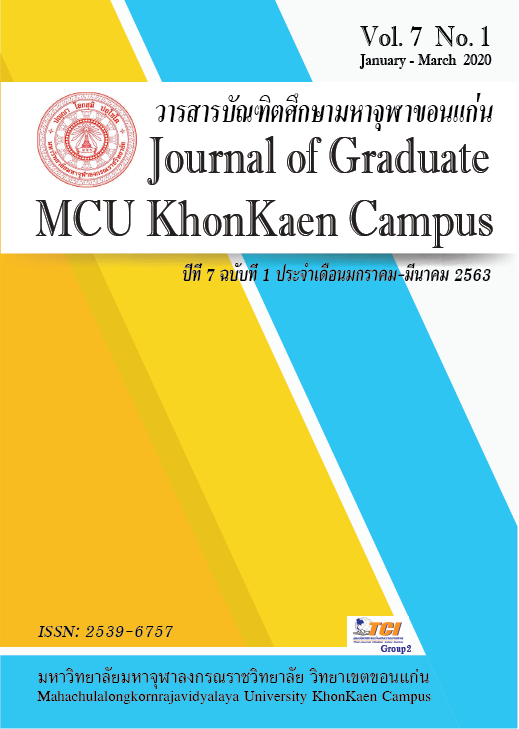DIRECTIONS AND PATTERN OF CARE FOR THAI OLDER PEOPLE
Main Article Content
Abstract
This article aimed to point out the directions and pattern of care for Thai older people. Nowadays, Thailand has changed in term of technology, society, culture, economy, health service and the increasing trend of older people population. Affect form the condition, there is a need to adjusts the direction of the older people care model to be suitable to respond to the care needs of older people according to their ability of life. Divided into well elder group, home bound elder group and bed bound elder group.
When sorting care in each form, there is a focus of pattern: The Well elder group with direction must take care of themselves first for adjusts behavior of themselves, control activities and continue in activity. Emphasize on promotion according to 4 smart pattern. The Home bound elder group focuses on shorting the duration of illness and living happily, focusing on promoting according to 5 Happy pattern. The Bed bound elder group focus on potential and live to decrease the occurrence of complications. Emphasize on promote according to long term care pattern. The family support is to build encouragement and create more continuity of activity, that good result in a lot of care for all older people. The community support will promoting the mechanism of action in the system of area. The support from government agencies and Private sector, will create line of a policy system, resulting in all driving in the same directions. So, The integration form every part is an important point in the direction and pattern of caring for the Thai older people.
Article Details
References
กิตติพร เนาว์สุวรรณ, ประไพพิศ สิงหเสม และวัลทณี นาคศรีสังข์. (2560). สมรรถนะที่จำเป็นต่อการดูแลผู้สูงอายุของพยาบาลวิชาชีพ
เมื่อเข้าสู่การเป็นสังคมผู้สูงอายุ. วารสารพยาบาลกระทรวงสาธารณสุข, 27(1), 1-11.
กรมอนามัย กระทรวงสาธารณสุข. (2561). คู่มือส่งเสริมสุขภาพผู้สูงอายุและป้องกันภาวะสมองเสื่อมสำหรับประชาชน: ไม่ล้ม ไม่ลืม ไม่
ซึมเศร้า กินข้าวอร่อย. กรุงเทพฯ : กรมอนามัย กระทรวงสาธารณสุข.
กระทรวงการพัฒนาสังคมและความมั่นคงของมนุษย์. (2561) .รายงานสถานการณ์ทางสังคมและความมั่นคงของมนุษย์ รายไตรมาส ปี
(มกราคม-มีนาคม).ออนไลน์. เข้าถึง เมื่อ5 ตุลาคม 2562. จาก :http://ebooks.msociety.go.th/
ebooks/view/350#page/1
กีรติ กิจธีระวุฒิวงษ์ และนิทรา กิจธีระวุฒิวงษ์. (2561). ทิศทางของการพัฒนาผู้ดูแลผู้สูงอายุระยะยาวในชุมชน. วารสารการพยาบาล
และการดูแลสุขภาพ, 36(4), 15 – 24.
จินตนา อาจสันเที๊ยะ และรัชณีย์ ป้อมทอง. (2561). แนวโน้มการดูแลผู้สูงอายุในศตวรรษที่21 : ความท้าทายในการพยาบาล. วารสาร
พยาบาลทหารบก, 19(1), 39-46.
มูลนิธิสถาบันวิจัยและพัฒนาผู้สูงอายุไทย. (2560). สถานการณผูสูงอายุไทย พ.ศ.2560. นนทบุรี: โรงพิมพเอพลัสมีเดีย.
สุดารัตน์ นามกระจ่าง, ลักษณี สมรัตน์ และอนัญญา เดชะคำภู. (2560). ประสิทธิผลของโปรแกรมพัฒนาความสุข 5 มิติในผู้สูงอายุ:
กรณีศึกษาในผู้สูงอายุตำบลกระหวัน อำเภอขุนหาญ จังหวัดศรีสะเกษ. การประชุมวิชาการเสนอผลงานวิจัยบัณฑิตศึกษา ระดับ
ชาติและนานาชาติ 2560. วันที่ 10 มีนาคม 2560 ณ อาคารพจน์ สารสินมหาวิทยาลัยขอนแก่น. 699- 707
สำนักงานสถิติแห่งชาติ (2560). การสำรวจประชากรสูงอายุในประเทศไทย พ.ศ. 2560. สืบค้น 5 ตุลาคม 2562, จาก
:http://www.nso.go.th/sites/2014/Pages/News/2561/N08-02-61-1.aspx
สำนักงานหลักประกันสุขภาพแห่งชาติ, 2559. การบริการสุขภาพเพื่อลดความเหลื่อมล้ำ และค่าใช้จ่ายในการดูแลสุขภาพของครัวเรือน.
สืบค้น 5 ตุลาคม 2562, จาก :http://stream.nhso.go.th/wp-content/uploads/ebooks/annual-2017/#page=28

